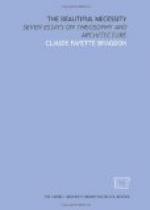[Illustration 60: EGYPTIAN; GREEK; ROMAN; MEDIAEVAL]
[Illustration 61: JEFFERSON’S PEN SKETCH FOR THE ROTUNDA OF THE UNIVERSITY OF VIRGINIA]
[Illustration 62: APPLICATION OF THE EQUILATERAL TRIANGLE TO THE ERECHTHEUM AT ATHENS]
[Illustration 63]
[Illustration 64: THE EQUILATERAL TRIANGLE IN ROMAN ARCHITECTURE]
But architecture is geometrical in another and a higher sense than this. Emerson says: “The pleasure a palace or a temple gives the eye is that an order and a method has been communicated to stones, so that they speak and geometrize, become tender or sublime with expression.” All truly great and beautiful works of architecture from the Egyptian pyramids to the cathedrals of Ile-de-France—are harmoniously proportioned, their principal and subsidiary masses being related, sometimes obviously, more often obscurely, to certain symmetrical figures of geometry, which though invisible to the sight and not consciously present in the mind of the beholder, yet perform the important function of cooerdinating the entire fabric into one easily remembered whole. Upon some such principle is surely founded what Symonds calls “that severe and lofty art of composition which seeks the highest beauty of design in architectural harmony supreme, above the melodies of gracefulness of detail.”
[Illustration 65: THE EQUILATERAL TRIANGLE IN ITALIAN ARCHITECTURE]
[Illustration 66: THE HEXAGRAM IN GOTHIC ARCHITECTURE]
There is abundant evidence in support of the theory that the builders of antiquity, the masonic guilds of the Middle Ages, and the architects of the Italian Renaissance, knew and followed certain rules, but though this theory be denied or even disproved—if after all these men obtained their results unconsciously—their creations so lend themselves to a geometrical analysis that the claim for the existence of certain canons of proportion, based on geometry, remains unimpeached.
[Illustration 67]
[Illustration 68]
The plane figures principally employed in determining architectural proportion are the circle, the equilateral triangle, and the square—which also yields the right angled isosceles triangle. It will be noted that these are the two dimensional correlatives of the sphere, the tetrahedron and the cube, mentioned as being among the determining forms in molecular structure. The question naturally arises, why the circle, the equilateral triangle and the square? Because, aside from the fact that they are of all plane figures the most elementary, they are intimately related to the body of man, as has been shown (Illustration 45), and the body of man is as it were the architectural archetype. But this simply removes the inquiry to a different field, it is not an answer. Why is the body of man so constructed and related? This leads us, as does every question, to the threshold of a mystery upon which theosophy alone is able to throw light. Any extended elucidation would be out of place here: it is sufficient to remind the reader that the circle is the symbol of the universe; the equilateral triangle, of the higher trinity (atma, buddhi, manas); and the square, of the lower quaternary of man’s sevenfold nature.




